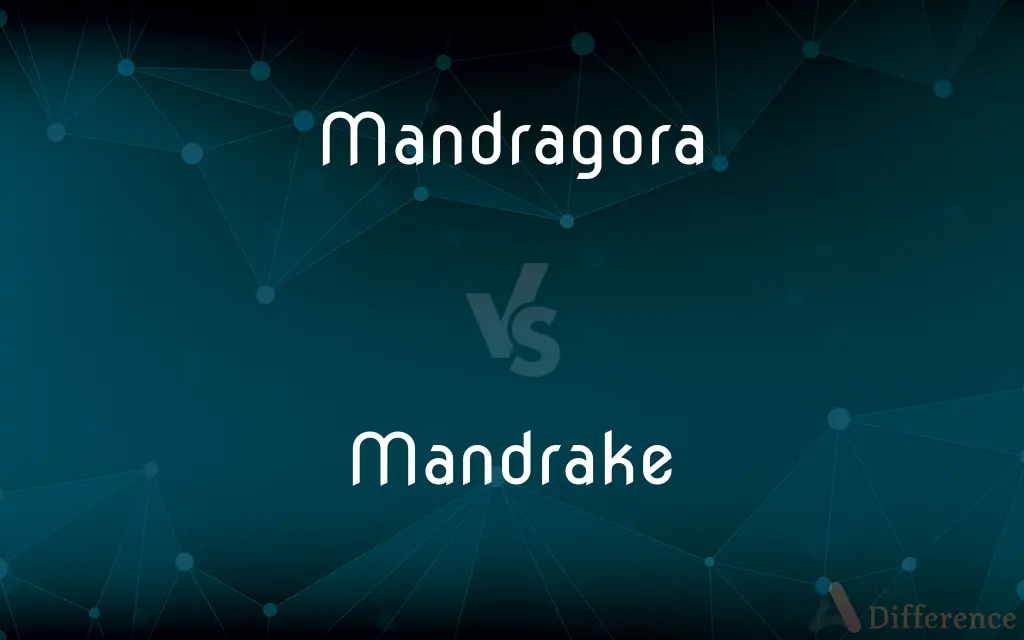Mandragora vs. Mandrake — What's the Difference?
By Tayyaba Rehman & Urooj Arif — Updated on April 24, 2024
Mandragora refers to the plant genus encompassing several species, known for their medicinal properties, whereas "mandrake" commonly describes the Mandragora officinarum species, noted for its root's human-like shape.

Difference Between Mandragora and Mandrake
Table of Contents
ADVERTISEMENT
Key Differences
Mandragora is the scientific name for a genus of plants in the nightshade family, recognized for their ethnobotanical importance throughout history. On the other hand, mandrake typically refers to the specific species Mandragora officinarum, which has been mythologized in folklore for its supposed magical properties.
The roots of Mandragora plants, particularly those of the mandrake, are famed for their peculiar, often humanoid appearance, which has led to numerous cultural and mystical associations. Whereas the mandrake is specifically noted for this characteristic and has a richer folklore presence, involving tales of its shriek when uprooted.
The entire Mandragora genus has been used historically in various cultures for its sedative and anesthetic properties. In contrast, mandrake's reputation includes not only medicinal uses but also superstitions, such as its use in love potions and magical rituals.
In terms of cultivation, Mandragora species, including the mandrake, require specific growing conditions, thriving in Mediterranean climates. However, the mandrake is particularly noted for its sensitivity and the difficulty associated with its cultivation due to its slow growth and specific soil requirements.
While both Mandragora and mandrake are part of the same plant family and share many chemical constituents, they differ in the popular imagination and cultural significance. Mandrake holds a place in literature and art that extends beyond the botanical scope of Mandragora.
ADVERTISEMENT
Mandragora species are diverse, with several types found across the Mediterranean and parts of the Middle East. However, when people refer to a mandrake, they are often picturing the Mandragora officinarum, encapsulated in myths and depicted frequently in medieval and Renaissance art.
Comparison Chart
Scientific Scope
Genus including several species
Commonly refers to the species Mandragora officinarum
Cultural Significance
Significant in ethnobotany and medicine
Rich in folklore and mystical attributes
Root Appearance
Varied, often with a thick, root-like appearance
Notably humanoid-shaped roots
Medicinal Uses
Used as sedatives and anesthetics across species
Famed for similar uses plus mystical uses
Cultivation
Grows in Mediterranean climates, diverse species
Difficult to grow, requires specific conditions
Compare with Definitions
Mandragora
Plants characterized by their large roots and potent chemical compounds.
Mandragora roots are harvested carefully due to their potent alkaloids.
Mandrake
A plant species under the Mandragora genus, famed for its human-like roots.
The gardener showed the children a mandrake root, explaining its unusual shape.
Mandragora
Historically used for their sedative and hallucinogenic properties.
Ancient surgeons used Mandragora as an anesthetic during surgeries.
Mandrake
Requires specific growing conditions and is known for its rarity and cultivation challenges.
Growing mandrake successfully requires patience and expert gardening skills.
Mandragora
Associated with a variety of cultural and historical contexts.
Mandragora has been a subject of study in both historical botany and folklore.
Mandrake
Often appears in literature and art due to its distinctive and eerie human resemblance.
The mandrake features prominently in Renaissance paintings, symbolizing mysticism.
Mandragora
Found in Mediterranean and Middle Eastern regions.
He studied the diverse species of Mandragora native to the Mediterranean basin.
Mandrake
Associated with numerous legends and myths, particularly in European folklore.
The mandrake is often depicted in stories as having magical properties.
Mandragora
A genus of plants in the nightshade family, known for their medicinal properties.
The herbalist cultivated several types of Mandragora for their natural remedies.
Mandrake
Used historically in medicine and magic, often surrounded by superstition.
Medieval texts describe the mandrake as a powerful component in spells and potions.
Mandragora
See mandrake.
Mandrake
A mandrake is the root of a plant, historically derived either from plants of the genus Mandragora found in the Mediterranean region, or from other species, such as Bryonia alba, the English mandrake, which have similar properties. The plants from which the root is obtained are also called "mandrakes".
Mandragora
Mandrake (genus Mandragora); often specifically mandrake root, traditionally used as a narcotic.
Mandrake
A southern European plant (Mandragora officinarum) in the nightshade family, having greenish-yellow flowers and a branched root. This plant was once believed to have magical powers because its root resembles the human body.
Mandragora
A kind of tiny dragon immune to fire.
Mandrake
The root of this plant, which contains the poisonous alkaloid hyoscyamine. In both senses also called mandragora.
Mandragora
A genus of plants; the mandrake. See Mandrake, 1.
Mandrake
See mayapple.
Mandragora
A genus of stemless herbs of the family Solanaceae
Mandrake
(mythology) A mandragora, a kind of tiny demon immune to fire.
Mandrake
Any plant of the genus Mandragora, certain of which are said to have medicinal properties; the root of these plants often resembles the shape of a small person, hence occasioning various mythic, magical, or occult uses.
Mandrake
A root of a mandrake plant that resembled human form, especially one kept or used for magic or occult purposes.
Mandrake
(slang) The drug methaqualone.
Mandrake
A low plant (Mandragora officinarum) of the Nightshade family, having a fleshy root, often forked, and supposed to resemble a man. It was therefore supposed to have animal life, and to cry out when pulled up. All parts of the plant are strongly narcotic. It is found in the Mediterranean region.
And shrieks like mandrakes, torn out of the earth,That living mortals, hearing them, run mad.
Mandrake
The May apple (Podophyllum peltatum). See May apple under May, and Podophyllum.
Mandrake
The root of the mandrake plant; used medicinally or as a narcotic
Mandrake
A plant of southern Europe and North Africa having purple flowers, yellow fruits and a forked root formerly thought to have magical powers
Common Curiosities
What distinguishes Mandragora from mandrake in botanical terms?
Mandragora is the genus name, encompassing various species, while mandrake specifically refers to the species Mandragora officinarum.
What are the primary uses of mandrake in folklore?
In folklore, mandrake is used for its supposed magical powers, including inducing love, wealth, and protection.
Can all Mandragora species be used medicinally?
Yes, various species within the Mandragora genus are used for their medicinal properties, particularly as sedatives and anesthetics.
How do the growing conditions of Mandragora and mandrake differ?
While both thrive in Mediterranean climates, mandrake is particularly noted for requiring more specific conditions and is harder to cultivate successfully.
What role does the mandrake play in literature?
The mandrake has appeared in literature as a symbol of mysticism and the supernatural, notably in works from the medieval period to modern fantasy.
What precautions should be taken when using mandrake in herbal remedies?
Due to its potent chemicals, precise dosages and expert knowledge are essential when using mandrake medicinally to avoid toxicity.
Are Mandragora plants safe to handle?
Handling Mandragora plants, especially the roots, should be done with care due to their potent alkaloids, which can be toxic.
How do Mandragora and mandrake differ in their root structures?
While Mandragora roots vary, mandrake roots are particularly noted for resembling human figures, which adds to their folklore appeal.
Why is the mandrake considered to have magical properties?
The mandrake's human-like root appearance and its hallucinogenic effects have contributed to its mystical reputation throughout history.
What are the challenges associated with cultivating mandrake?
Mandrake requires specific soil types, climate conditions, and careful handling due to its slow growth and sensitive nature.
How does the efficacy of Mandragora species as anesthetics compare to modern methods?
While historically significant, the anesthetic properties of Mandragora species are less effective and much riskier than modern anesthetics.
Can Mandragora and mandrake be found in herbal stores?
Mandragora, especially mandrake, may be available in specialized herbal stores or from suppliers of rare plants and herbs.
What are the historical contexts in which Mandragora was used?
Mandragora has been used from ancient times in Greek and Roman medicine, through medieval European practices, up to its present use in traditional remedies.
How is mandrake depicted in visual arts?
Mandrake is often depicted in visual arts as a mystical and enigmatic element, with its human-like roots symbolizing hidden powers and secrets.
Is there a cultural significance to the different species of Mandragora?
Yes, different species of Mandragora hold varying significances across cultures, particularly in traditional medicines and folklore.
Share Your Discovery

Previous Comparison
Orange vs. Nectarine
Next Comparison
Agenda vs. AgendumAuthor Spotlight
Written by
Tayyaba RehmanTayyaba Rehman is a distinguished writer, currently serving as a primary contributor to askdifference.com. As a researcher in semantics and etymology, Tayyaba's passion for the complexity of languages and their distinctions has found a perfect home on the platform. Tayyaba delves into the intricacies of language, distinguishing between commonly confused words and phrases, thereby providing clarity for readers worldwide.
Co-written by
Urooj ArifUrooj is a skilled content writer at Ask Difference, known for her exceptional ability to simplify complex topics into engaging and informative content. With a passion for research and a flair for clear, concise writing, she consistently delivers articles that resonate with our diverse audience.
















































